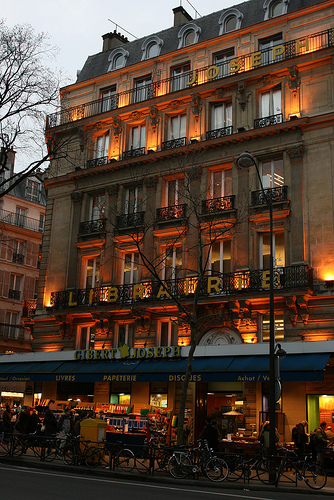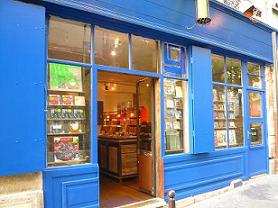This Saturday (18 April) is World Record Store Day, when punters are encouraged to support their local music dealers. It’s a good opportunity to tell you about our favourite French record shops – and encourage you to tip us off about ones we haven’t discovered yet.
High-street record shops in France are quite good, with breadth and depth to their stock. Should you find yourself in a busy shopping area in a French city, chances are you’re close to an outlet of FNAC, an excellent chain of home entertainment and multimedia stores. Their music space is usually divided into large sections for rock, French, jazz, classical, urban and world music, and each section has its own information desk where the staff (in their distinctive green and yellow waistcoats) tend to be quite knowledgeable. The FNAC on the Champs-Élysées in Paris is open until midnight, like the neighbouring Virgin Megastore (also very good) – there’s something magical about being in a record shop late at night, as if all the best music only comes out after dark. And because the Champs-Élysées is a designated tourist zone, both stores can open on Sundays.
As well as being a fine store, we also commend FNAC for their Indétendances series of samplers and summertime Paris concerts, giving valuable mainstream exposure to up-and-coming French acts of various styles. And the larger FNAC stores have a dedicated space for live performances – in particular we recall a full-on, plugged-in, amped-up set by Grenoble band Rhesus at the FNAC near Montparnasse one Saturday afternoon.
 Even better than FNAC, in our view, is Gibert Joseph (right), a book and music seller that can also be found in many major French towns. In Paris, you can find Gibert Joseph halfway up the Boulevard Saint Michel, the record shop at number 34 a few doors past the bookstore. (Warning: don’t confuse Gibert Joseph with Gibert Jeune, the virtually-similar group of bookshops around the fountain in Place Saint Michel.)
Even better than FNAC, in our view, is Gibert Joseph (right), a book and music seller that can also be found in many major French towns. In Paris, you can find Gibert Joseph halfway up the Boulevard Saint Michel, the record shop at number 34 a few doors past the bookstore. (Warning: don’t confuse Gibert Joseph with Gibert Jeune, the virtually-similar group of bookshops around the fountain in Place Saint Michel.)
Gibert Joseph’s main virtue is that they sell new and second-hand music side by side. You can even find the latest releases marked with a yellow sticker that says ‘Occasion’, the French term for second-hand, at discount prices and shelved beside new copies at full price. Gibert Joseph has the best alternative music section of any French high-street chain. They also have live sessions. And, if you’ll forgive the digression, the bookstore has new and second-hand English reading material on the fourth floor, though we should also mention the small second-hand English bookstores nearby around the Odéon.
If you crave the real independent music store experience in Paris, simply go out the door of Gibert Joseph, cross the Boulevard Saint Michel and you’ll find rue des Écoles, home to small second-hand shops like Crocodisc. The nearby O’CD has become successful and opened many branches, but at a price: like many small record stores in Paris, it now stocks more DVDs than music.
Then, further along the street, turn right and go up rue de la Montaigne Saint Geneviève. At the very top, just before you come up behind the Panthéon, you have La Dame Blanche, which specializes in jazz and classical music on vinyl. Even if you don’t do the wax, some of those old classical LPs have wonderful sleeves – dig the scary head on young Daniel Barenboim! Half the pleasure of visiting record stores is simply flicking through the stock and finding an album cover that’s surreal, kitsch or slightly troubling. (Another digression: round the corner from La Dame Blanche is the Bombardier, a very nice English pub with filling meals and football on TV.)
But what’s the best record store in Paris? Well, our choice is well outside the city centre – you’ll need to take the metro to Belleville in the east and then push your way through the busy streets of this ethnic, working-class area. Suddenly you’ll fall across Place Saint Marthe, a quiet cobblestone square that has boho cafés on one side. On the other side is the record store, Ground Zero.
 Ground Zero (left) is small and homey – we know it’s a converted house because there’s still a sink in one corner. Like Road Records in Dublin, it stocks the latest indie releases and correctly assumes that you already own the essential classics. Their main trade is in the sort of alternative guitar pop that attracts shy, bookish male punters who then shuffle timidly up to the girls behind the counter.
Ground Zero (left) is small and homey – we know it’s a converted house because there’s still a sink in one corner. Like Road Records in Dublin, it stocks the latest indie releases and correctly assumes that you already own the essential classics. Their main trade is in the sort of alternative guitar pop that attracts shy, bookish male punters who then shuffle timidly up to the girls behind the counter.
And, crucially, it sells product from local acts – you’re likely to find records by Paris-based singers and bands displayed in boxes on the counter. In particular, Ground Zero seems to be a favourite of the extended Herman Dune family, who have performed in-store sessions there.
So, this World Record Store Day your correspondent will head for Ground Zero near Belleville in Paris to buy albums and give the twinkly eye to those shop assistants.
On our rare trips outside Paris, we’ve made sure to look for local independent record shops. Should your holidays take you into deep France, we have two recommendations: Planet R in Saint Lô in Normandy and Sofa in Lyon. And there are Gibert Joseph record shops in Versailles and Lyon – we’ve been there, we know that they exist.
If you know any other good record shops in France, especially outside Paris, or if you have a memorable record-buying experience from your school tour or last holiday here, tell us about it with a comment below. Live from Ground Zero in Paris, here's Herman Dune and Julie Doiron singing 'With A Fistful Of Faith':
More ...
[Read more...]